More Junkmail from Bob!
Thursday, May 13, 2004Important Stuff.
Sun Trouble
On March 12, there was an explosion on the sun. Or maybe it was inside the sun. Actually, the sun is made up of constant explosions. Big ones. Nuclear fusion, like millions of hydrogen bombs. This time, the sun blew part of itself away.

The official name of this is an "eruptive prominence." The cloud in the upper right of the picture is a bunch of plasma that at only 80,000°C, is much cooler than the surrounding corona's 2,000,000°C. This plasma was blasted away from the sun at about 45,000 mph on March 12.
This probably is not the end of the sun as we know it. This sort of thing happens occasionally and is associated with coronal mass ejections.
A few days later, a large iceberg in the southern Earth broke in half. This too was caused by the sun, which relentlessly bombarded the iceberg and surrounding water with visible light, infrared, and ultraviolet radiation. Well, it was probably the sun, although unnamed administration officials believe enemy combatants with possible links to Al Kider may have been involved.
In October 1998, an iceberg broke off of the Ronne Ice Shelf in Antarctica. This was not unusual, but the size of this iceberg was -- about 30 miles by 90 miles. It was the largest on Earth in about 10 years.

A large piece of that iceberg broke off and floated north about 1500 miles to the South Georgia area -- the islands east of the Falklands, not the state. The original iceberg was called A38, and the large piece that broke off in 1998 is called A38B.
There the warmer air, warmer water, and ocean currents caused A38B to break in half last month. It was about 23 x 26 miles in size. Here's what it looked like:
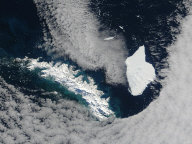
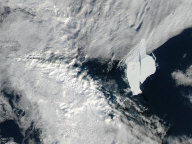
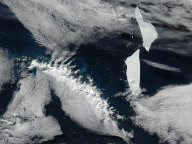
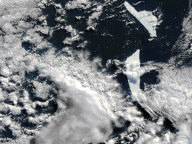
Want to find an iceberg's location? Look on the internet, of course:
http://www.natice.noaa.gov/products/iceberg/index.htm
Get Secure!
To keep terrorists away, the FBI and the Justice Department want even more internet eavesdropping capability. They want "ready access to any form of internet communication." Without a search warrant. Some privacy fans are not pleased. The Justice Department said, "We can assure you that the wiretapping will never be abused, just as detainees who are held without charge are never abused."
http://zdnet.com.com/2100-1107_2-5194394.html
On April 27 in Buffalo, NY Bush said, using his creative grammar, "The Patriot Act defends our liberty, is what it does, under the Constitution of the United States." Here all along, I had it backwards.
http://www.whitehouse.gov/news/releases/2004/04/20040420-2.html
On April 28, the ACLU was allowed to disclose a lawsuit they filed against the Patriot Act. They still couldn't release the details. Why? Under a provision of the Patriot Act, it was illegal for them to tell anybody about the lawsuit. It sounds a lot like the secret police to me. I don't know whether the lawsuit amounts to anything, but it worries me when the government keeps things covered up like that. What was that Bush said on the 27th?
http://www.aclu.org/SafeandFree/SafeandFree.cfm?ID=15555
Good news! When the U.S. signs onto the Convention on Cybercrime, not only will the FBI be allowed to tap into my computer without a warrant, but so will 37 other countries. That makes me feel safe! I sure wouldn't want to impede an Albanian computer investigation. I'm stretching it a little bit when I say they'll be able to "tap into my computer," but only a little bit.
http://www.securityfocus.com/news/8529
DMCA and Google
Some people are claiming that the brilliant law, the Digital Millennium Copyright Act, requires Google and other search engines to remove links to material that anybody claims to be violating a copyright. There doesn't have to be any proof. An allegation of copyright violation is all it takes for Google to be required under law to remove links to web site.
I can think of all sorts of fun people will have with this one.
http://xpda.com/junkmail/junk156/v9i1_a02-Walker.pdf
Venus Transit
Venus will be crossing in front of the Sun on June 8. No person alive has ever seen this happen, but lots plan to. It happens on an average of once every 243 years or so. You can join in the fun! Join the Venus Transit Project and record you sightings.
http://www.vt-2004.org/participate/
You should be able to see it in the northeastern half of the U.S.
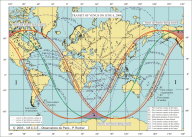
Stupid Software Patents
We've finally seen the end of the patent on the .gif file format. Now some worm-brain at Forgent Technologies, a company that develops lawsuits, has decided they've got a patent on the .jpg file format. Naturally they didn't develop any .jpg ideas, algorithms (which are not supposed to be patentable anyway), or processes. They just bought the patent and started suing people.
http://www.wired.com/news/business/0,1367,63200,00.html
The EFF is trying to fight stupid software patents, some of which are pretty ridiculous in my opinion (and theirs).
http://www.eff.org/Patent/
Microsoft received a patent last month for "a time based hardware button for application launch." That's already widely implemented on watches, remote controls, cars, appliances, and some Apple computers. There's no way anybody with half a brain could consider that innovative and original.
http://lawgeek.typepad.com/lawgeek/2004/04/silly_internet__2.html
The Patent
But Microsoft has collected over 1000 patents in the past couple of years, about 10 a week. We shouldn't expect those poor folks and the USPTO to make sure they're ALL original, should we? That might require some common sense.
http://www.eweek.com/article2/0,1759,1566299,00.asp
The National Research Council says the US Patent and Trademark Office needs to improve. They did a study paid for, among others, by some bigtime patent holders such as IBM, Merck, Pharmacia, and Procter & Gamble. In each of the past 11 years, IBM has received more patents than any other company in the world.
http://wired.com/news/business/0,1367,63248,00.html
Here's the official report online, about 150 pages worth:
http://books.nap.edu/books/0309089107/html/index.html
In response, the USPTO said, "Give us more money and maybe we'll do a better job."
Sudan on the Human Rights Commission
Things are not going so well in Sudan. In the past year, more than 10,000 people have been killed and about a million forced to leave home. Massacres are common, and it's generally understood that the Sudanese government is supporting the violence.
http://news.bbc.co.uk/2/hi/africa/3652521.stm
It's a good thing we have the United Nations Human Rights Commission. That's the one that the U.S. got kicked off of in 2001. (The U.S. is back on now.) But Sudan is also a member of the United Nations Human Rights Commission, has been since 2002, and was just confirmed for next year. Good idea.
http://www.reuters.co.uk/newsArticle.jhtml;?type=topNews&storyID=5041363
http://www.cnn.com/2004/WORLD/africa/05/03/un.human.rights.ap
...and liberty and Wi-fi for all.
The Open Park Project is bringing free wireless internet to the Washington Mall, even for miscreants like me!
http://www.openpark.net
Elsewhere in Washington, the Marian Koshland Science Museum is now open! It's a new science museum that's supposed to be pretty good. I'll have to check it out if I'm ever allowed inside the beltway.
http://www.koshland-science-museum.org/
Spam Cans
In the last Junkmail (or two) I might have made a few derogatory statements about how the Justice Department has been refusing to prosecute anybody under the anti-spam law that took effect on January 1. I may even have implied that they're incapable or incompetent or incontinent or something.
I was wrong. A couple of weeks ago, Daniel, James, Mark, and Christopher were arrested and charged with emailing fraudulent email to unsuspecting innocents such as me.
http://wired.com/news/ebiz/0,1272,63275,00.html
What can you do to help? Forward your spam to the FTC at: mailto:uce@ftc.gov
You can also send your spam to Spamcop. Spamcop is a pretty interesting organization. A lot of companies, including Upperspace, check the Spamcop Blacklist and flag or bounce emails on the black list. How do spammers get on the Spamcop blacklist? It happens when other people forward spam complaints to Spamcop. Spamcop doesn't adjudicate anything, they just collect complaints. When there are enough complaints about one site, they go on the blacklist until the complaints go away.
It works pretty good and handles about 95% of the spam I get. However, a Northern California District Judge said that Spamcop is illegal now. Self-proclaimed "Spam King" Scott filed a lawsuit against Spamcop. The Judge said, "Spam King Scott has every right to break the law, and Spamcop is not nice. Spammers have an fundamental right under the Constitution and, even more important, under the Patriot Act to mess up the Internet." Or something like that.
http://zdnet.com.com/2100-1104-5210518.html
Elsewhere in cyberspace, Yahoo, Earthlink, AOL, and Microsoft have sued a few hundred spammers under the anti-spam law:
http://www.wired.com/wired/archive/12.05/view.html?pg=3
At Upperspace, blacklisted spam is flagged with [spam] in the subject line. Other email servers may put similar things into spam subject lines. In Outlook or Outlook Express, you can create a rule that automatically deletes or moves every message with [spam] in the subject line to a separate folder. To set up a rule for this in Outlook Express, in the menu go to Tools, Message Rules, Mail.
Hubble Robotics
NASA may try to service the Hubble Space Telescope with a robot. I hope it works.
http://www.cnn.com/2004/TECH/space/04/27/hubble.repairsII/index.html
Women? What Women?
Some women's organizations are a little perturbed by the disappearance of government information, web sites, and publications on women. A White House spokesman said, "This was not an intentional slant. We just thought most women can't read."
http://news.reuters.com/newsArticle.jhtml?type=domesticNews&storyID=4977467
What is a Link?
Sami Al-Hussayen is on trial in Boise Idaho. The U.S. is prosecuting him for providing expert advice or assistance to terrorists. What did he do? He maintained a web site. He didn't provide the content. He also was a moderator on a Yahoo discussion group about Chechnya, although he didn't do much moderating.
When asked if he'd gotten carried away with terrorist hysteria, Attorney General John replied, "What do you mean? He's GOT to be guilty of something. His name sounds like Saddam Hussein!" I hope John doesn't visit Al Kider's site.
http://www.reason.com/sullum/043004.shtml
Basic Programming
The Basic computer language is 40 years old. Despite all the harassment by Chandler at OSU, I still use it.
http://www.computerworld.com/news/2004/story/0,11280,92795,00.html
Diebold in California
Last Junkmail I mentioned that the state of California probably wouldn't throw out the Diebold electronics voting machines. I was wrong -- they did!
http://www.nbcsandiego.com/news/3255945/detail.html
http://www.wired.com/news/evote/0,2645,63298,00.html
Windows 98 SE Service Pack
Microsoft occasionally gathers up all their Windows updates and combines them into a single service pack that you can install to make sure you've got all their patches. They never got around to this for Windows 98 SE. So someone else did. I haven't tried this so I'm not sure how well it works, but here it is -- the "unauthorized" Win98SE Service Pack:
http://exuberant.ms11.net/98sesp.html
Bush's "Bus" Tour
I heard on the news that Bush was on a bus tour through Michigan and Ohio. First I thought that was interesting, because Bush (and most recent Presidents) rarely travel on the ground. Then I wondered what the airspace would look like. Would they shut down thousands of square miles of private air traffic around Bush like they normally do (unlike any other President)? This would be a huge area if he dragged it across two entire states.
It turns out that his bus tour was mostly an air tour. He would fly to one location, take the bus a few miles for some campaign speeches, fund raising, and photo ops, and then fly on to cover some distance.
http://www.washingtonpost.com/wp-dyn/articles/A178-2004May4.html
He still managed to shut down a lot of airspace. Here's what it looked like in Ohio. It looks like he flew into Dayton and out of Cincinnati, or vice versa. The restricted area covered a good portion of southwestern Ohio.
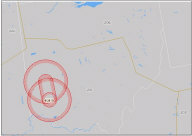
Ray Guns
Northrop Grumman has developed a high-power chemical laser for the U.S. and Israeli armies to shoot down incoming rockets and artillery shells. They've been testing it successfully for a couple of years now.

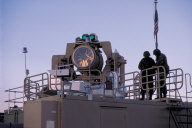
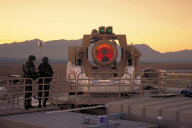
http://www.irconnect.com/noc/press/pages/news_releases.mhtml?d=57129
Here's the movie:
http://www.st.northropgrumman.com/media/SiteFiles/mediagallery/video/MTHEL_m.wmv
The weapon uses a deuterium-fluoride laser. It uses the gases nitrogen trifluoride, ethylene, helium, and deuterium to generate lasing action. It also uses water and hydrogen peroxide for cooling and pressure recovery. This paper explains it pretty well:
http://xpda.com/junkmail/junk156/SPIE_Manuscript_Tactical_high-energy_laser.pdf
Movie Taper
A guy named Ruben was sent to jail for video taping a movie in California. He was sentenced to 42 days in jail and three years probation. That seems a little stiff to me.
http://www.cnn.com/2004/SHOWBIZ/Movies/05/10/pirate.jail.reut/index.html
Sub Trouble
A Danish trawler caught a German submarine in its nets during NATO exercises. Both boats surrendered. The same thing happened 10 years ago, but the fishing boat sank that time.
http://news.bbc.co.uk/2/hi/europe/3702477.stm
In what I think are the same NATO exercises, the USS Swift lost a 2-ton unmanned submarine off the coast of Norway. It eventually washed up on the beach and was discovered by a hiker.
http://www.aftenposten.no/english/local/article788134.ece
Considering this a challenge to their national honor, the British HMS Penzance lost its unmanned sub shortly afterward.
http://www.aftenposten.no/english/local/article792261.ece
Both submersibles are used for charting and searching for mines.
Ukraine Barbecue
There was a fire at a Ukrainian arms dump. It had about 300,000 tones of various types ammunition when the fire started. Now there's not much left. Thousands were evacuated, and the fire and explosions went on for at least four days.
http://news.bbc.co.uk/2/hi/europe/3701167.stm
What About Mars?

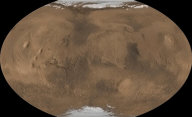
With the Mars Explorer Rovers tooling around on the martian surface, Mars has been in the news a lot lately. I decided to look some stuff up on Mars that I've probably read before, but somehow over the years it leaked out of my brain. I suspect my ears are to blame. Actually, most of this stuff was not in the old World Book Encyclopedia where I did most of my Mars research about 100 years ago.
I might put all this Mars stuff on a separate site, so email me when you find my mistakes.
Mars is flying around the Sun, just like Earth. Well, not JUST like Earth. Mars is a little farther from the Sun -- an average of 52% farther, at 227,920,000 km. The orbit of Mars is a less round than that of the Earth. The Earth varies in its distance from the sun by about 4%, while Mars varies 21%.
http://xpda.com/junkmail/junk156/relorb.gif
Mars is smaller than Earth, a little over half the Earth's diameter. Between that "tootha third" thing they use in volume calculations and a density 29% less than that of Earth, Mars weighs only 11% as much as Earth. If I was going to be astronomically and physically correct I would probably refer to Mars's mass instead of its weight, but I'm not so I didn't. But coincidentally, the mass of Mars is also only 11% as much as the mass of Earth.
Gravity is on Mars is 38% as strong as Earth's gravity. Maybe this is larger than 11% because of the smaller diameter of Mars.
It's surprising to me that Mars is that much less dense than earth. Venus and Mercury have densities closer to Earth's, but the outer planets get less dense.
A compass won't work on Mars because there is no global magnetic field. But there probably used to be one.
Atmosphere
Mars has air. The martian atmospheric pressure is somewhere .09 to .13 pounds per square inch, or 6.3 to 9 millibars. That's a pretty large fluctuation. It's also a low pressure. That's as much air as you would get on Earth at an altitude of 110,000 to 120,000 feet. The martian atmosphere is 95% carbon dioxide and 3% nitrogen. Water makes up 0.02% of the atmosphere.
The air pressure on Mars fluctuates seasonally when the carbon dioxide ice caps at the polar regions sublime completely (northern summer) or retreat (southern summer). Since there's not much air, the amount that evaporates in the summer is enough to raise the global air pressure by 25% or so.
Water
There are ice caps on Mars. The southern ice cap stays around all year. It's mainly dry ice -- carbon dioxide. The northern ice cap has water ice underneath carbon dioxide ice. The carbon dioxide ice of the northern ice cap evaporates (sublimes) every summer, leaving behind the water ice cap. When the southern ice cap retreats to its minimum size in the summer, there is only dry ice left on the surface except for a little water ice along the edge.
On Mars there is quite a bit of water ice in the ground in the polar regions. More than 50% of the near-surface material is made up of frozen water.
http://marsprogram.jpl.nasa.gov/odyssey/gallery/science/PIA04908.html
There is also frozen water near the surface over the rest of the planet. Most of the area outside the polar regions has 5%-10% water in the near-surface material.
http://marsprogram.jpl.nasa.gov/odyssey/gallery/science/PIA04907.html
These are estimates from the Odyssey spacecraft that's currently flying around Mars. They use a gamma ray spectrometer to measure the amount of hydrogen, and from that they get the amount of water.
http://marsprogram.jpl.nasa.gov/odyssey/technology/grs.html
http://marsprogram.jpl.nasa.gov/odyssey/newsroom/pressreleases/20031208a.html
Here's the northern ice cap in early summer:

This photo, taken February by the Mars Global Surveyor, shows something that looks like water ice:

The Global Surveyor has been orbiting Mars since 1998 taking pictures and collecting data. It has taken several pictures of gullies that were most likely caused by liquid water. Here's one:
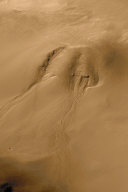
These gullies are on the side of this crater:
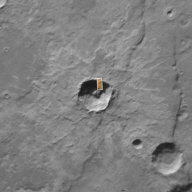
Here are more signs of erosion caused by liquid water on Mars, with explanations:
http://marsprogram.jpl.nasa.gov/mgs/msss/camera/images/june2000/index.html
These gullies were probably caused by water melting underneath a snowpack:

"This visible-light image, taken by Mars Odyssey, indicates that gullies on martian crater walls may be carved by liquid water melting from remnant snow packs. The gullies in the top right-center appear to emerge from beneath and within a gradually disappearing blanket of snow. The current snow pack in this crater appears to remain only on the cold, pole facing crater wall (top). On the less-shaded, warmer sides of the crater (left), the snow cover has completely disappeared, leaving the gullies exposed. The image shows an area 14.8 kilometers (9.2 miles) by 21.6 kilometers (13.4 miles). North is toward the top, and illumination is from the left."
Here's another, from Global Surveyor:
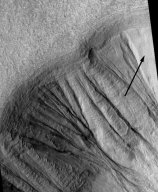
"This image, taken by Mars Global Surveyor spacecraft, shows gullies on martian crater walls that may be carved by liquid water melting from remnant snow packs. Numerous gullies are seen, with a remnant of the snow pack (arrow) proposed to be the source of water that eroded the gullies. This Mars orbiter camera image (number M09-2875) covers an area of 2.8 kilometers (1.7 miles) by 4.5 kilometers (2.8 miles) and is located at 33.3 degrees south, 92.9 degrees east. North is toward the top, and illumination is from the left."
There might be liquid water on Mars today about 500 meters below the surface, but it's too cold and there's too little air pressure for liquid water on the surface today.
Here are a couple of papers on martian water:
http://xpda.com/junkmail/junk156/hend.mola.pdf
http://xpda.com/junkmail/junk156/1080497v1.pdf
This picture from the Mars Rover Opportunity last Saturday. It looks like a water run-off, it probably just looks that way.
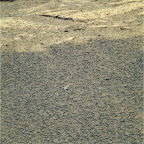
Weather
It's cold on Mars! The average surface temperature is cold, anyway, at -81F (-63C).
| Minimum | Maximum | |
| Polar Night | -199F (-128C) | |
| Equatorial Day | 80F (27C) | |
| Pathfinder | 14F (-10C) | -105F (-76C) |
| Mars Exploration Rover Est. | 32F (0C) | -148F (-100C) |
The maximum temperature is around 98F (37C) and the minimum is around -190F (-123C). These are pretty extreme cases. The Mars Pathfinder recorded temperatures at its landing site between 14F (-10C) and -105F (-76C). There is a big daily fluctuation because of the thin air.
There are clouds and snow on Mars, but the snow is dry ice (carbon dioxide) instead of water ice.
http://ltpwww.gsfc.nasa.gov/tharsis/clouds&snow.html
The wind on Mars can blow up to 80 mph, but because the air is so thin there it doesn't push dust, spacecraft, and bicycles nearly as hard as an 80 mph wind does on earth. But the martian wind can generate giant dust storms.
In 1971, two Soviet spacecraft, Mars 2 and Mars 3, and the U.S. Mariner 9 arrived in orbit around Mars. When they got there, there was essentially nothing to see because of the huge dust storm raging around the planet. The dust storm had been obscuring the normally prominent features on Mars for months. Mars 2 and Mars 3 used film cameras, scanned the file and transmitted that back to Earth. They ran out of film before the storm ran out of wind. Here's an image from Mars 3:

...and one from Mariner 9 on its approach:

Mariner 9 waited out the storm and got some good pictures after the dust settled. Mariner 9 used a television camera. Digital cameras were not generally available in 1971. This is a picture of the Olympus Mons, just like the ones above from Viking and Global Surveyor.
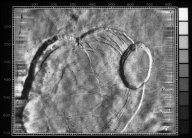
Date and Time
A year on Mars is 687 Earth days long, and 668 martian days long. Because of the orbit of Mars isn't as circular as Earth's, there is more variation in the length of martian seasons. The martian Summer is 199 days long, and the Winter is only 146 days.
http://cmex-www.arc.nasa.gov/CMEX/data/MarsEssy/seasons/seasons.htm
On Earth, there are Julian Days. That is the number of days since January 1, 4713 BC. That turns out to be a large number, and is a little hard to remember. So people frequently use the Modified Julian Day (MJD), which is the number of days since the midnight beginning November 17, 1858. This is 2.4 million and a half days after January 1, 4713 BC.
Not to be left out, the Martians came up with the Mars Sol Date (MSD), which is the number of martian days since about Earth noon on December 29, 1873. This beginning date was picked because it was before most of the technical observations of martian details, and because of some other coincidental times of that date that I didn't go into enough to understand.
There have been several proposals for Mars month-year calendars, but none have been generally accepted.
For the record, today is MJD 53137 and MSD 46341. This will be on the test.
What time is it on Mars? It gets a little complicated.
The martian day is exactly about 24 hours. However, martian hours, minutes, and seconds are all about 2.3% longer than those on earth. I think it was the martians who decided to keep time that way several years ago so that's how we do it now, rather than having a 24 hour, 39 minute, 35.2 second day.
Before railroads and telegraphs shrank the size of the earth, time was generally kept as "local time" rather than in time zones. This meant that it was noon whenever the sun was at its peak, and the other 23 hours were adjusted accordingly. This is one reason that old towns used to have large city clocks. Then they drew lines separating the earth into time zones of about 15° longitude. That way you didn't have to change your watch each time the train stopped, and you could arrange to send a telegraph to another town at a certain time without knowing when the sun peaked there.
NASA and some others use Local Solar Time on Mars sometimes. This makes it easy to see, for example, when a picture was taken relative to when the sun was highest in the sky. However, Mars wobbles on its axis and flies around the sun in a less than circular manner, making the Local Solar Noon a little irregular. Mean Solar Time uses the "average" noon. True Solar Time uses the actual noon. The difference on earth is within about 14 or 16 minutes. On Mars, it can vary -51 to +40 minutes.
It takes some ciphering to figure out what the true Local Solar Time is. At precisely 10:30 p.m. CDT today (Tuesday, May 11, 2004) it's 03:04:46 at the rover Spirit's landing site, and 15:00:45 at Opportunity's landing site. It's not possible to use a fixed number of seconds to find out what time it will be tomorrow, because using Local Solar Time the day lengths change.
So we have yet another time to contend with, although this one is easier. The Mission Time for each rover was set to zero on the Local Solar Midnight before landing. The day was set to zero also. Each mission day has the average martian day length of 87755.24 earth seconds, so it's easy to compute. They even made some special slow-running watches for some of the people on the NASA rover teams to use.
At 10:30 p.m. CDT today, the Spirit Mission Time was 02:41:18 on Sol 127. "Sol 127" means the 127th martian day of the mission. At that time, Opportunity Mission Time was 14:40:08 on Sol 106. The seconds and minutes on the two mission times are different because they used the Local Solar Midnight for time reference.
Naturally I did all these computations in my head, including the effects of the orbital eccentricity of Mars, but you can use a program if you need to. Here's a java executable to calculate various martian times and dates. There's a good explanation of how it's done, too.
http://xpda.com/junkmail/junk156/Mars24J.zip
Here is some information on martian time:
http://www.giss.nasa.gov/tools/mars24/help/notes.html
Terrain
Mars has some big mountains and valleys. The Olympus Mons is the largest known volcano in the solar system. It's about 16 miles tall, about three times as high as Mt. Everest. The picture above from Mariner 9 is the central cauldera from Olympus Mons. Here's one from Viking, taken in 1978:

This is a picture of the edge of the Olympus Mons cauldera (the hole in the middle). It's 5 miles across, taken by Mars Global Surveyor last year. You can see a lava flow that was cut off when the cauldera collapsed. This area is about 12 miles above "sea level" on Mars. Since there's no sea, they use some average base elevation.

The canyon system of the Valles Marineris is the largest and deepest known in the solar sytem. It's 2500 miles long and up to 6 miles deep:

The Moons
Mars has two moons, Phobos and Deimos. They're probably asteroids captured by the Mars gravity. Phobos is only 6.9 miles long, and orbits Mars about 5.5 times per week:
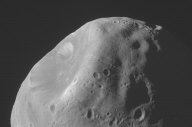

Deimos is even smaller with a length of 3.2 miles. It orbits Mars a little over 3 times per day.
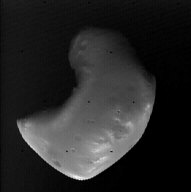
Here are what Deimos and Phobos look like when they fly across the sun. It's not exactly a total eclipse.
http://marsrovers.jpl.nasa.gov/gallery/press/opportunity/20040311a.html
History
The U.S.S.R and U.S. started sending things to Mars 44 years ago, in 1960. The first six tries didn't work out. The seventh launch, the 4 by the U.S. was Mariner 4 on November 28, 1964. It made a successful flyby of Mars 8 months later. The pictures returned by Mariner 4 look really primitive by today's standards:
http://xpda.com/mars/mariner4
There were less than 25 images returned by Mariner 4, compared to tens of thousands already returned by the two Mars Explorer Rovers this year.
In 1969, the same year Apollo 11 made the first moon landing, Mariner 6 and 7 made a Mars flyby and returned 75 and 126 images of Mars.
http://xpda.com/mars/mariner6
http://xpda.com/mars/mariner7
In 1971, the USSR and US were competing to launch the first vehicle to orbit another planet. The U.S. was first to launch, with Mariner 8 on a Centaur rocket on May 8. But a few minutes after the launch, the guidance system failed and Mariner 8 was destroyed, landing in the ocean a few hundred miles northwest of Puerto Rico.
Then the Soviet Union launched Mars 2 and Mars 3 on May 19 and 28. On May 30, the U.S. launched Mariner 9, which made it to Mars orbit two weeks before Mars 2 on November 13. Mariner 9 was the first spacecraft to orbit another planet, even though it was launched after two others headed to the same planet.
Mars 2 and Mars 3 had landers. The Mars 2 lander's retro-rockets didn't fire when they were supposed to, and it burned up due to a steep entry into the atmosphere.
On December 2, 1971, the Mars 3 lander was the first spacecraft to land on Mars. Here's the official story:
"The descent module was separated from the orbiter on 2 December 1971 at 09:14 UT. (There is an uncertainty in the absolute times stated here of about 3 minutes.) Fifteen minutes later the descent engine was fired to point the aeroshield forward. At 13:47 UT the module entered the martian atmosphere at 5.7 km/sec at an angle less than 10 degrees. The braking parachute was then deployed, followed by the main chute which was reefed until the craft dropped below supersonic velocity, at which time it was fully deployed, the heat shield was ejected, and the radar altimeter was turned on. At an altitude of 20 to 30 meters at a velocity of 60 - 110 m/s the main parachute was disconnected and a small rocket propelled it off to the side. Simultaneously the lander retrorockets were fired. The entire atmospheric entry sequence took a little over 3 minutes.
"Mars 3 impacted the surface at a reported 20.7 m/s at approximately 45 degrees S, 158 degrees W, at 13:50:35 UT. Shock absorbers inside the capsule were designed to prevent damage to the instruments. The four petal shaped covers opened and the capsule began transmitting to the Mars 3 orbiter at 13:52:05 UT, 90 seconds after landing. After 20 seconds, at 13:52:25, transmission stopped for unknown reasons and no further signals were received at Earth from the martian surface. It is not known whether the fault originated with the lander or the communications relay on the orbiter. A partial panoramic image returned showed no detail and a very low illumination of 50 lux. The cause of the failure may have been related to the extremely powerful martian dust storm taking place at the time which may have induced a coronal discharge, damaging the communications system. The dust storm would also explain the poor image lighting."
Mariner 9 was more successful and returned 7,329 photos of Mars, Martians, and the surrounding territory. Here are a few:
http://xpda.com/mars/mariner9
In 1974 the Soviet Mars 5 spacecraft arrived in Mars orbit. It was to be a communications link for the Mars 6 and Mars 7 landers, which would arrive the following month. Mars 5 lost pressure in its transmitter housing and failed after 9 days, 22 orbits, and about 60 photos. The Mars 6 lander hit the ground too hard and was destroyed, and the Mars 7 Lander missed the planet. Here are some pictures from Mars 5:
http://xpda.com/mars/mars5
In 1975, the U.S. launched Viking 1 and 2, each with an orbiter and lander, arriving at Mars in 1975. The Viking landers returned data from the martian surface from until 1982 and 1980. The orbiters were active until 1980 and 1987. 12 years is a long time for a spacecraft to operate in orbit around Mars, especially one launched in the 1970's.
The Viking spacecraft together returned more than 50,000 photos. Here are 55 of them. Actually, most of these are a combination of several photos:
http://xpda.com/mars/viking
After Viking you'd think we have this Mars spacecraft stuff figured out, but since then seven and a half out of the next 11 launches failed, up to but not including the successful Mars Exploration Rovers currently wandering around the planet. Here's list of the Mars spacecraft launched to date.
The Pathfinder was the first martian lander with a ground vehicle, although it was pretty small. Here's a good panorama from Pathfinder that shows the rover.
Here's the Pathfinder rover on Mars:
http://xpda.com/junkmail/junk156/sol30S55.gif
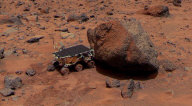
You can browse images from Global Surveyor, Pathfinder, and Odyssey (and most other NASA spacecraft) here:
http://photojournal.jpl.nasa.gov/PIADetQuery.html
Here are some Mars Express images:
http://xpda.com/mars/marsexpress
Here is a list of all the Mars missions, successful or not, before 2003:
http://marsprogram.jpl.nasa.gov/missions/log/
Mars "Backgrounder" from NASA:
http://xpda.com/junkmail/junk156/MarsGlance.pdf
Technical Data for Mars:
http://nssdc.gsfc.nasa.gov/planetary/factsheet/marsfact.html
And finally, Mars in Color (new and improved!):
http://xpda.com/mars
Pictures of Today!
Some big game photos from Florida and South Carolina:
















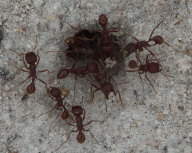








Legal Notice
(-) copyrite 1928, No rights deserved. Unauthorized duplication, distribution, replication, or publication of this find collection of zeros and ones is fine with me.
If you'd like to sign up for your very own Junkmail emailed to your very own inbox irregularly and erratically, go to
http://xpda.com/junkmail
You can read, and search the archives there, too.
If you'd like to stop getting Junkmail, please select any of the following fun-filled options:
1. Get a new email address.
2. Move out of internet range.
3. Stop computing.
4. Send me an email with "Kangerlussuaq" as the subject.
I'm Bob Webster from Pryor. I can usually be reached at bob@xpda.com
Have a nice day!